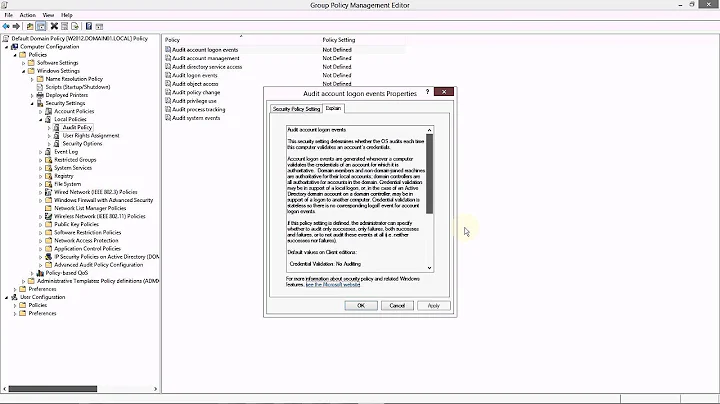Windows Server 2012 R2 Essentials .local to .com easy change? Probably hard or not possible though
Why do you want to change the root domain? What are the reasons... If it causes you no issues then there is no need to change it.
You can change all the users UPN by adding a new UPN in the Domains and Trusts tool.
See this link.
https://support.microsoft.com/en-us/kb/243629
If you have a reason other than the users routable upn, let me know and we can see if there is a work around.
I have never had to change a domain name or reinstall one yet.
Yours
Ed
Related videos on Youtube
Comments
-
 timd1971 almost 2 years
timd1971 almost 2 yearsAfter installing Windows Server 2012 R2 Essentials with a .local suffix, now I read that .local is a big no no... and need to change it from SERVER.MYDOMAIN.local to SERVER.MYDOMAIN.com.
Sarching high and low and Youtube, apparently it can be done, but a zillion steps to do a simple name change. Very risky indeed. And yes, way above my head, but did run across this:
in case of link-rot, here it is:
December 15, 2013 How to Specify Windows 2012R2 Essentials Top Level Domain (TLD) Suffix
Upon installing my first Windows 2012R2 Essentials server I discovered it would not let me use domain suffixes .net, .corp, .com, .org etc. It defaulted the DNS suffix to “.local”. I am not sure why Microsoft is saying this is a best practice since there are numerous complaints about integrating .local domain with cloud services, contention with multicast/Apple bonjour services and the major Certificate Authorities with will no longer release Certs for .local, .priv and .corp (see link)
To get around it this bug (see link) I refer to powershell again.
1.Enter the Powershell prompt.
2.To get the credentials to create your domain admin account enter the following: PS C:> $cred = Get-Credential –UserName LocalAdmin –Message “Please specify the password for your new administrator account.”
3.To start the domain controller promotion commandlet enter the following:
PS C:\> Start-WssConfigurationService -CompanyName “Contoso” -DNSName “Test.Contoso.com” -NetBiosName “Test” -ComputerName “YourServerName” –NewAdminCredential $cred -Setting AllAnd that’s it! I hope this helps.
Seems too good to be true right? Anyone know if this in fact works?
I'd like to change .local before I get way too far along with this basic small office server setup on about 5 devices. By the way, it's my office, I am not a IT pro doing this for others, it's a learning process for me, so please bear with me.
If this isn't a solution... any good ones that may help? I guess even starting completely over won't even give me the option to change it to .com correct? I do own a external .com domain name also. therefore the SERVER part of SERVER.MYDOMAIN.com versus www.MYDOMAIN.com.
I did find this also...something about a custom cfg.ini.
https://support.microsoft.com/en-us/kb/2830511
Will any of this work on R2 also? As I noticed some findings are for Windows Server 2012 Essentials (sans R2).
I think this is going to be a hard question to answer. :/
MORE USEFUL INFO. HOPE MY QUESTION HELPS PEOPLE!: http://www.em-soft.si/myblog/elvis/?p=403
I guess I would never had this problem if I just purchased the STANDARD edition and CALS for it.
HERE IS THE ANSWER!: Windows Server 2012 R2 Essentials unable to install using .com, etc. domain suffix
-
 joeqwerty almost 9 yearsThe links you posted are unrelated to renaming the AD domain. I don't think it's possible to rename an AD domain with Essentials. You're probably looking at having to start from scratch.
joeqwerty almost 9 yearsThe links you posted are unrelated to renaming the AD domain. I don't think it's possible to rename an AD domain with Essentials. You're probably looking at having to start from scratch. -
 timd1971 almost 9 yearsBefore I do, I'll try installing the trial on a VM and see if possible. I'd hate to do all this again and the wizard still won't let you do a .com versus a .local as I have heard this is the case. I have also heard you can STOP this wizard and do it manually. But yet, again, would have to try on a VM before wasting a bunch of time on the physical server. I know most of the people here use STANDARD or above, but wonder if anyone has any experience with this .local problem ESSENTIALS inflicts or is everyone just ignoring it and leaving it at .local instead of fixing it properly?
timd1971 almost 9 yearsBefore I do, I'll try installing the trial on a VM and see if possible. I'd hate to do all this again and the wizard still won't let you do a .com versus a .local as I have heard this is the case. I have also heard you can STOP this wizard and do it manually. But yet, again, would have to try on a VM before wasting a bunch of time on the physical server. I know most of the people here use STANDARD or above, but wonder if anyone has any experience with this .local problem ESSENTIALS inflicts or is everyone just ignoring it and leaving it at .local instead of fixing it properly? -
 timd1971 almost 9 yearsran out of chars. "The links you posted are unrelated to renaming the AD domain." Either way, as I guess I am confused what exactly the links present then, I just want it to be SERVER.MYDOMAIN.com, not SERVER.MYDOMAIN.local simply...even though it sounds like it may not be simple at all for whatever reason. Is this a built in problem so one is forced to use STANDARD edition to use (rename to) .com rather than forced upon .local by ESSENTIALS?
timd1971 almost 9 yearsran out of chars. "The links you posted are unrelated to renaming the AD domain." Either way, as I guess I am confused what exactly the links present then, I just want it to be SERVER.MYDOMAIN.com, not SERVER.MYDOMAIN.local simply...even though it sounds like it may not be simple at all for whatever reason. Is this a built in problem so one is forced to use STANDARD edition to use (rename to) .com rather than forced upon .local by ESSENTIALS? -
 timd1971 almost 9 years"Hugs... Painful, right?" huh?
timd1971 almost 9 years"Hugs... Painful, right?" huh? -
 timd1971 almost 9 yearsdo these accomplish what I am looking for? Appears .local can be renamed? jeremyrnelson.wordpress.com/2013/10/24/… or this one: mizitechinfo.wordpress.com/2013/06/10/…
timd1971 almost 9 yearsdo these accomplish what I am looking for? Appears .local can be renamed? jeremyrnelson.wordpress.com/2013/10/24/… or this one: mizitechinfo.wordpress.com/2013/06/10/… -
 timd1971 almost 9 yearsI am now using a VM to test scenarios before I do this on the physical server. I am finding out I can CANCEL the CONFIGURE wizard, and use Server Manager to accomplish what I need maybe. And I also just found this: em-soft.si/myblog/elvis/?p=403
timd1971 almost 9 yearsI am now using a VM to test scenarios before I do this on the physical server. I am finding out I can CANCEL the CONFIGURE wizard, and use Server Manager to accomplish what I need maybe. And I also just found this: em-soft.si/myblog/elvis/?p=403 -
Joel Coel almost 9 yearsI'm gonna go with option C: really bad idea. .local isn't great, but .com is no better.
-
 timd1971 almost 9 yearsPlease elaborate why .com is no better. What's so wrong with AD.MYDOMAIN.com??? hmmmmmm? :S
timd1971 almost 9 yearsPlease elaborate why .com is no better. What's so wrong with AD.MYDOMAIN.com??? hmmmmmm? :S
-






